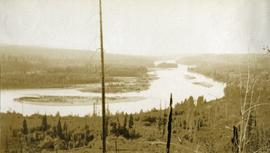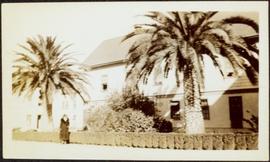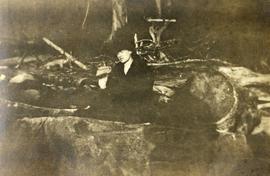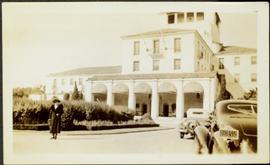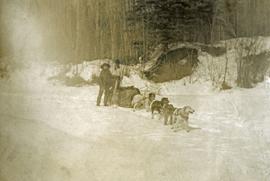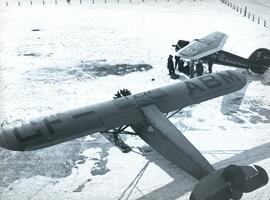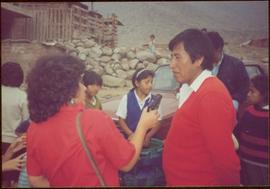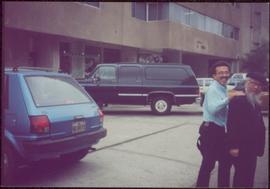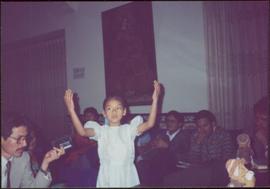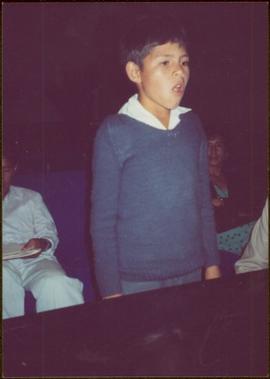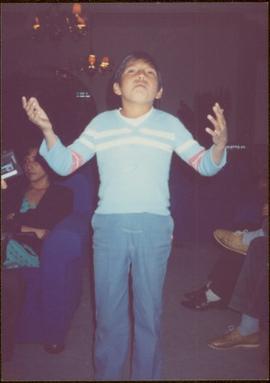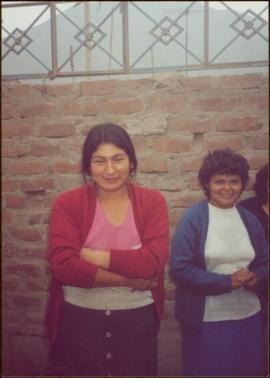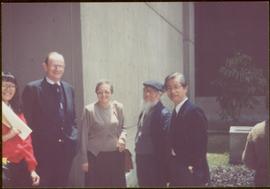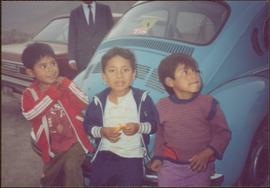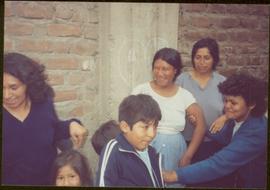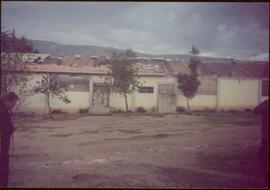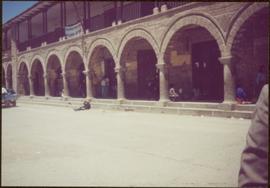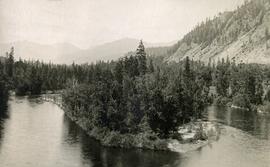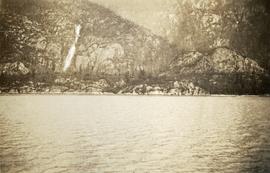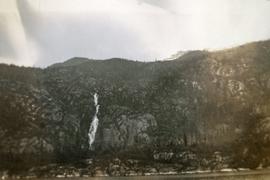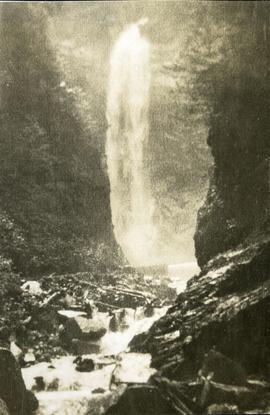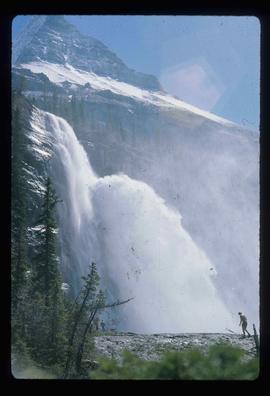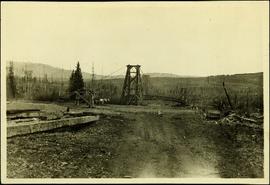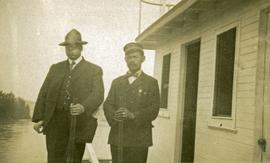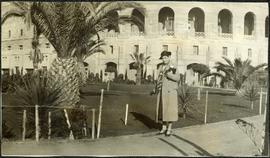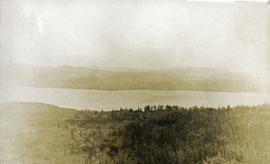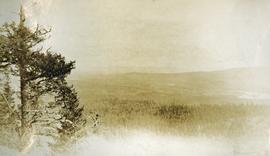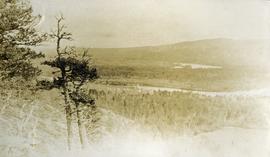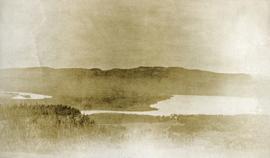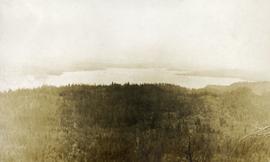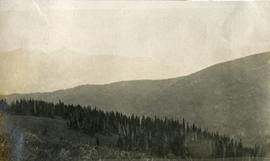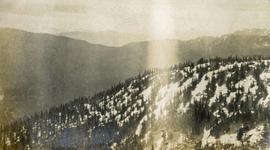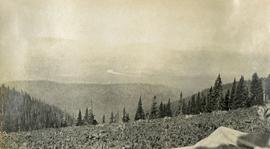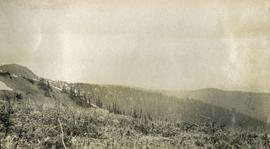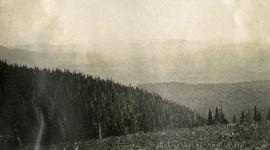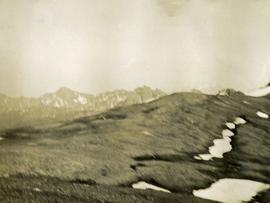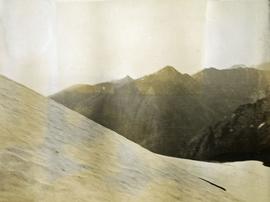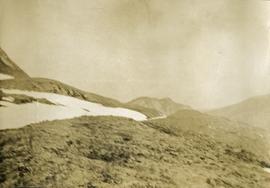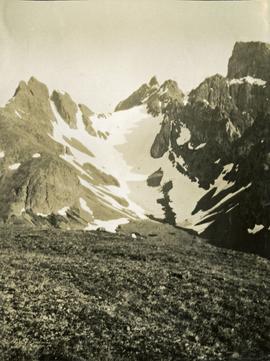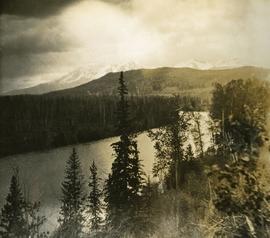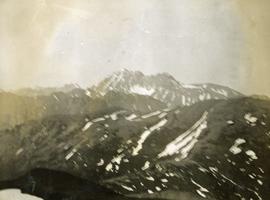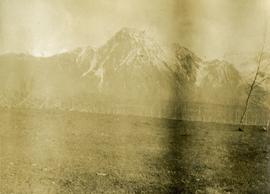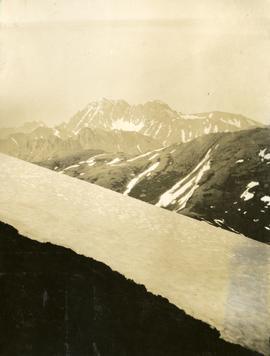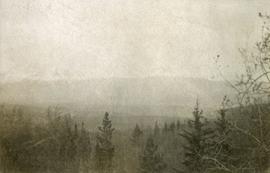File consists of notes and reproductions relating to the Yukon Telegraph Trail, which runs through British Columbia from Ashcroft in the south to Atlin in the North. The telegraph line was constructed by the Dominion Government Telegraph Service from 1898 to 1901. The groundwork for this telegraph line was laid by the Collins Overland Telegraph and the Western Union Telegraph (Russian-American Telegraph). File also includes photographs depicting a cabin at Bobtail Lake along the telegraph trail (1977).
Photograph depicts a view looking down from a high forested slope to Woodpecker Island on the Fraser River, BC.
Two Women sit on hood of car parked in mud road, one man stands on right. Forest in background.
Woman stands in front of trimmed hedges and palm trees, tall buildings in background. Photograph speculated to depict Sarah Glassey in a warm location such as Los Angeles, California.
Photograph depicts a woman sitting on a rock, driftwood in the background.
Photograph speculated to depict Sarah Glassey in a warm location such as Los Angeles, California. Large building with tiled roof stands in background, cars in right foreground.
Photograph depicts two people and a dog team on a snowy river bank with a narrow passage of open water and a snowy bluff in the background.
Photograph depicts a four-dog team harnessed to a loaded sleigh. Two people stand near the loaded sleigh on a snowy forest path.
Photograph depicts Jewitt's CF-ABM Fairchild 71 aircraft and a group of men surrounding a Detroit News aircraft NR-32-M, both located at Edmonton Airport.
Willard Freer, a packer and guide in remote northern BC, kept a daily diary from 1942 to 1975 that provides a detailed record of life in northern BC and southern Yukon Territory. This collection consists of digital replicas of Willard Freer's diaries from 1942 to 1975, along with accompanying transcripts created by Jay Sherwood, who authored a book about Freer's life.
Excerpts describing the Freer Diaries from "Kechika Chronicler: Willard Freer's Northern BC & Yukon Diaries, 1942-1975" by Jay Sherwood (2023), pages 14-17:
In a letter that [Willard Freer] wrote in 1935, he stated that he had started keeping a diary when he left home. Unfortunately, his early diaries have been lost. In the summer of 1939, while Freer was away working, the BC Provincial Police investigated his neighbour Frank "Shorty" Weber as a suspect in a local murder. The police seized Freer's diaries from his trapping cabin as potential evidence. Freer wrote to the police requesting the return of his diaries, but he never received them. Fortunately, Freer had made copies of his diaries for the summers of 1932 and 1934. His diary for 1934 is particularly important because he was a member of the Bedaux Expedition.
Freer's existing diaries begin in the spring of 1942, when he was still living in the Ingenika River valley, and continue until 1975. The notebook for 1950 and 1951 is missing, and the January to September 1961 section has been removed. ...
Throughout his adult life, Freer wrote a daily journal. The entries are usually brief and direct, with minimal philosophizing. They are often repetitive, describing daily routines. However, the cumulative narrative of Freer's diaries provides a rare look into the history of one of British Columbia's most remote areas.
The pantheon of people recorded in Freer's diaries include many notable individuals who lived and worked in the Kechika River valley and along the Alaska Highway. Willard's journals provide details about specific events in the lives of these people. There are many references to the famous bush pilots Stan Bridcut and George Dalziel. He notes several prospectors who are well-known in northern BC and Yukon.
Willard's work involved extensive travel through northern BC and Yukon. His diaries provide details about the locations he visited. In particular, Freer kept an important record of travel on the Davie Trail between Fort Ware and Lower Post. For every overnight trip he made, Freer recorded the campsite he used, and the amount of time he spent travelling each day.
During the 1940s and 1950s, the Kaska and Kwadacha Tsek'ene still followed their traditional yearly rounds in the Kechika drainage. Freer's diaries detail the lives and routines of numerous Indigenous people over many years. Some of them are mentioned over a hundred times in Freer's diaries. By all accounts, Willard had good relationships with the Indigenous people. In the remote northern BC and Yukon region, where there were few people, working co-operatively was important.
Willard lived and worked at Skook Davidson's Diamond J Ranch during most of the 1940s and at intervals in the 1950s, so his journals provide considerable information about Skook and life at the ranch.
...
Freer's diaries contain considerable information about daily life in the lodges along the Alaska Highway.
...
Freer was involved in many important projects in northern BC and Yukon. He was a member of the famous 1934 Bedaux Expedition. Freer was a packer for BC and federal government survey crews for several summers; worked on the British Columbia-Yukon Boundary Survey for four years; was employed on Geological Survey of Canada (GSC) crews for several years; and spent three field seasons on the BC government's Forest Inventory program. Willard also packed for a couple of large mining exploration companies and was a hunting guide for Robin Dalziel and other guide outfitters.
Freer's diaries can also be used to monitor events like the weather and snowfall. In the winter, when he lived at Skook's ranch or at his cabin, he recorded the temperature in the morning, at midday, and in the evening. He also noted snowfalls. Willard recorded the date that the Kechika froze over in the fall, and when the ice melted off the river in the spring. He also noted his first observations of birds in the spring.
...
The diaries of Willard Freer, which chronicle over thirty years of life in northern BC, are a unique account, providing a gateway to many of the people who lived there and some of the important events that occurred.
Rock pile, unknown building, and hills can be seen in background.
Photograph is one of 11 images taken during a World Health Organization (WHO) trip, Human Rights of Women and Children, Peru, 1990. Possibly affiliated with World Council of Churches, International Ecumenical Delegation to Lima, Peru, 14-25 October 1990. See also items 2009.6.1.505 - 2009.6.1.515.
Vehicles and large cement building in background.
Photograph is one of 11 images taken during a World Health Organization (WHO) trip, Human Rights of Women and Children, Peru, 1990. Possibly affiliated with World Council of Churches, International Ecumenical Delegation to Lima, Peru, 14-25 October 1990. See also items 2009.6.1.505 - 2009.6.1.515.
Young girl stands among unidentified women and men seated around her. Man on far left holds tape recorder towards her.
Photograph is one of 11 images taken during a World Health Organization (WHO) trip, Human Rights of Women and Children, Peru, 1990. Possibly affiliated with World Council of Churches, International Ecumenical Delegation to Lima, Peru, 14-25 October 1990. See also items 2009.6.1.505 - 2009.6.1.515.
Unidentified man and woman sit in background.
Photograph is one of 11 images taken during a World Health Organization (WHO) trip, Human Rights of Women and Children, Peru, 1990. Possibly affiliated with World Council of Churches, International Ecumenical Delegation to Lima, Peru, 14-25 October 1990. See also items 2009.6.1.505 - 2009.6.1.515.
Young boy stands among unidentified women and men seated around him. Tape recorder is held towards him on far left.
Photograph is one of 11 images taken during a World Health Organization (WHO) trip, Human Rights of Women and Children, Peru, 1990. Possibly affiliated with World Council of Churches, International Ecumenical Delegation to Lima, Peru, 14-25 October 1990. See also items 2009.6.1.505 - 2009.6.1.514.
Photograph is one of 11 images taken during a World Health Organization (WHO) trip, Human Rights of Women and Children, Peru, 1990. Possibly affiliated with World Council of Churches, International Ecumenical Delegation to Lima, Peru, 14-25 October 1990. See also items 2009.6.1.506 - 2009.6.1.515.
The group stands in front of a cement building.
Photograph is one of 11 images taken during a World Health Organization (WHO) trip, Human Rights of Women and Children, Peru, 1990. Possibly affiliated with World Council of Churches, International Ecumenical Delegation to Lima, Peru, 14-25 October 1990. See also items 2009.6.1.505 - 2009.6.1.515.
Man wearing suit and tie is partially visible in background.
Photograph is one of 11 images taken during a World Health Organization (WHO) trip, Human Rights of Women and Children, Peru, 1990. Possibly affiliated with World Council of Churches, International Ecumenical Delegation to Lima, Peru, 14-25 October 1990. See also items 2009.6.1.505 - 2009.6.1.515.
The group stands in front of a brick wall.
Photograph is one of 11 images taken during a World Health Organization (WHO) trip, Human Rights of Women and Children, Peru, 1990. Possibly affiliated with World Council of Churches, International Ecumenical Delegation to Lima, Peru, 14-25 October 1990. See also items 2009.6.1.505 - 2009.6.1.515.
Trees in foreground, hills in background. Unidentified man stands on far left.
Photograph is one of 11 images taken during a World Health Organization (WHO) trip, Human Rights of Women and Children, Peru, 1990. Possibly affiliated with World Council of Churches, International Ecumenical Delegation to Lima, Peru, 14-25 October 1990. See also items 2009.6.1.505 - 2009.6.1.515.
Unidentified individuals can be seen walking and sitting behind arches. One man lies on street in foreground.
Photograph is one of 11 images taken during a World Health Organization (WHO) trip, Human Rights of Women and Children, Peru, 1990. Possibly affiliated with World Council of Churches, International Ecumenical Delegation to Lima, Peru, 14-25 October 1990. See also items 2009.6.1.505 - 2009.6.1.515.
Photograph depicts a jut of treed land in the Kettle river.
Photograph depicts a waterfall on a rocky mountainside, an expanse of ocean in the foreground.
Photograph depicts a waterfall on a rocky mountainside. There are snow peaked mountains in the distance.
Photograph depicts a waterfall and stream with rocky banks.
Image depicts a waterfall with a mountain peak in the background; it is most likely Mt. Robson.
Handwritten annotation on recto of photograph: "Omineca Dist Walcott Suspension Bridge West Approach - looking East May 26 - 1932". Photograph depicts two white horses pulling a wagon in front of Walcott bridge. This bridge was moved from its original location in the Hagwilget Canyon, downstream from Walcott on the Bulkley River. It is a pedestrian bridge at the time of this photograph, though it was originally used by motor vehicles. Dirt road leading to bridge in foreground, with lumber and brush piles on either side. Trees and hills on opposite shore in background.
Photograph depicts two men in uniform standing beside a white building or steamboat. There is a water, likely the Chilcotin River, and trees in the background.
Virginia (nee Taylor) stands in long jacket, scarf, hat, and gloves, on smooth road. Behind her lies a groomed area with palm trees and ferns enclosed by rope fence. A large, stately building with detailed arches stands in background.
Photograph depicts a view of a lake and river from a high hill. Treed hills in the background.
Photograph depicts a view of immense rolling, treed hills.
Photograph depicts treed hills in the foreground. Buildings on a field near the river in the midground. Treed hills and a body of water in the background.
Photograph depicts a lake in the foreground, treed hills in the background.
Photograph depicts a view of a lake and river from a high hill. Treed hills in the background.
Photograph depicts a view of a lake and river from a high hill. Treed hills in the background.
Photograph depicts view of an alpine meadow, alpine trees and mountains in the background.
Photograph depicts scrub alpine trees with a layer of snow in the foreground and several mountain ranges in the distance.
Photograph depicts a view from a high mountain ridge looking down on forest, river and snowy mountain peaks in the distance.
Photograph depicts an alpine meadow in the foreground, forest, river and mountains in the distance.
Photograph depicts view of an alpine ridge with an alpine meadow in the foreground.
Photograph depicts alpine meadow in the foreground, forest, river and mountains in the distance.
Photograph depicts summit between John Brown and Kitseucla creeks.
Photograph depicts a view from the summit between John Brown and Kitseucla creeks.
Photograph depicts a view from the summit between John Brown and Kitseucla creeks.
Photograph depicts views from the summit between John Brown and Kitseucla creeks.
Photograph depicts a view looking down on the river with Hudson Bay mountain in the background.
Photograph depicts a view from the summit between John Brown and Kitseucla creeks.
Photograph depicts views from the summit between John Brown and Kitseucla creeks, Hudson Bay mountain.
Photograph depicts a view from the summit between John Brown and Kitseucla creeks.
Photograph depicts a few of forest in the foreground, a snowy mountain range in the distance.
